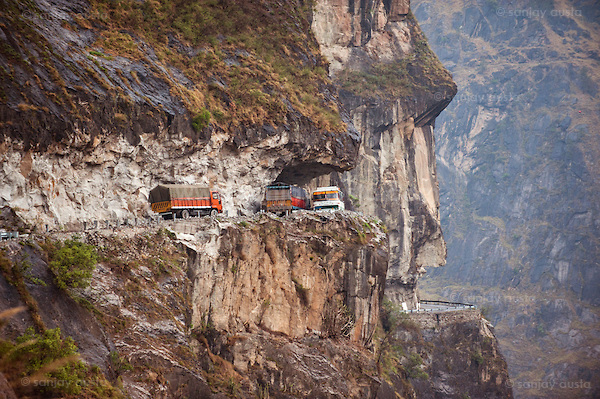World Dangerous road in kinnaur images
 Sangla Valley or the Baspa Valley starts at Karcham and ends at Chitkul. Sangla is the major town in the valley with having petrol pump, Bank ATMs, Post Office, Restaurants, Bar, mid range hotels and shops. The valley is surrounded by forested slopes and offers views of the high mountains. Its location in the greater Himalayan range gives it a milder climate than the plains. Until 1989 outsiders could not enter the valley without a special permit from the Government of India, due to its strategic position on the Indo-Tibet/China border.The Baspa River flows in the Sangla Valley which is rich in apple orchards, apricot, Wall-nut, Cedar trees, and glacial streams with trout. The main villages in the valley villages include Chitkul, Rakcham, Batseri, Themgarang, Kamru, and Sapni. The nearby Baspa hydel-project has been completed in 2009. Besides the natural beauty of Great Himalaya Kamru Fort, Mata Devi Temple & Bearing Nag Temples are the main attractions of the Valley.
Sangla Valley or the Baspa Valley starts at Karcham and ends at Chitkul. Sangla is the major town in the valley with having petrol pump, Bank ATMs, Post Office, Restaurants, Bar, mid range hotels and shops. The valley is surrounded by forested slopes and offers views of the high mountains. Its location in the greater Himalayan range gives it a milder climate than the plains. Until 1989 outsiders could not enter the valley without a special permit from the Government of India, due to its strategic position on the Indo-Tibet/China border.The Baspa River flows in the Sangla Valley which is rich in apple orchards, apricot, Wall-nut, Cedar trees, and glacial streams with trout. The main villages in the valley villages include Chitkul, Rakcham, Batseri, Themgarang, Kamru, and Sapni. The nearby Baspa hydel-project has been completed in 2009. Besides the natural beauty of Great Himalaya Kamru Fort, Mata Devi Temple & Bearing Nag Temples are the main attractions of the Valley.
 Sangla Valley or the Baspa Valley starts at Karcham and ends at Chitkul. Sangla is the major town in the valley with having petrol pump, Bank ATMs, Post Office, Restaurants, Bar, mid range hotels and shops. The valley is surrounded by forested slopes and offers views of the high mountains. Its location in the greater Himalayan range gives it a milder climate than the plains. Until 1989 outsiders could not enter the valley without a special permit from the Government of India, due to its strategic position on the Indo-Tibet/China border.The Baspa River flows in the Sangla Valley which is rich in apple orchards, apricot, Wall-nut, Cedar trees, and glacial streams with trout. The main villages in the valley villages include Chitkul, Rakcham, Batseri, Themgarang, Kamru, and Sapni. The nearby Baspa hydel-project has been completed in 2009. Besides the natural beauty of Great Himalaya Kamru Fort, Mata Devi Temple & Bearing Nag Temples are the main attractions of the Valley.
Sangla Valley or the Baspa Valley starts at Karcham and ends at Chitkul. Sangla is the major town in the valley with having petrol pump, Bank ATMs, Post Office, Restaurants, Bar, mid range hotels and shops. The valley is surrounded by forested slopes and offers views of the high mountains. Its location in the greater Himalayan range gives it a milder climate than the plains. Until 1989 outsiders could not enter the valley without a special permit from the Government of India, due to its strategic position on the Indo-Tibet/China border.The Baspa River flows in the Sangla Valley which is rich in apple orchards, apricot, Wall-nut, Cedar trees, and glacial streams with trout. The main villages in the valley villages include Chitkul, Rakcham, Batseri, Themgarang, Kamru, and Sapni. The nearby Baspa hydel-project has been completed in 2009. Besides the natural beauty of Great Himalaya Kamru Fort, Mata Devi Temple & Bearing Nag Temples are the main attractions of the Valley.
Winter Iamges
Sangla Valley is a part of Kinnaur and inhibited by Kinnauris. The main livelihood is agriculture while apples are a major cash crop here. The most significant achievement of this region which is worth laudable is that this area boasts of growing the world's best quality potatoes. The weather along with the soil are both conducive to its exclusive and superior variety and quality. A part of the population also depends on tourism. The valley remains closed for six months during winter (from December till may) when the snowfall is heavy. The old Indo-Tibet road connects Sangla to The National Highway 22 at Karcham.
Poo, or Pooh, also spelled Puh, (altitude 2,662 metres or 8,736 ft), is a small town in Kinnaur district, Himachal Pradesh, India. It is also known as "Spuwa". The approximate population given within a 7 km radius of the town is 1,192.Poo is 58 km from Powari village along National Highway 22. It is renowned for its natural beauty, green fields, apricot orchards, vineyards and almond trees. Inscriptions, suggest that Poo was an important trading center in the early 11th century.When A. H. Francke arrived in Poo from the south in July, 1910, it was the first village he found where the language was "entirely Tibetan"
Poo, or Pooh, also spelled Puh, (altitude 2,662 metres or 8,736 ft), is a small town in Kinnaur district, Himachal Pradesh, India. It is also known as "Spuwa". The approximate population given within a 7 km radius of the town is 1,192.Poo is 58 km from Powari village along National Highway 22. It is renowned for its natural beauty, green fields, apricot orchards, vineyards and almond trees. Inscriptions, suggest that Poo was an important trading center in the early 11th century.When A. H. Francke arrived in Poo from the south in July, 1910, it was the first village he found where the language was "entirely Tibetan"




No comments:
Post a Comment